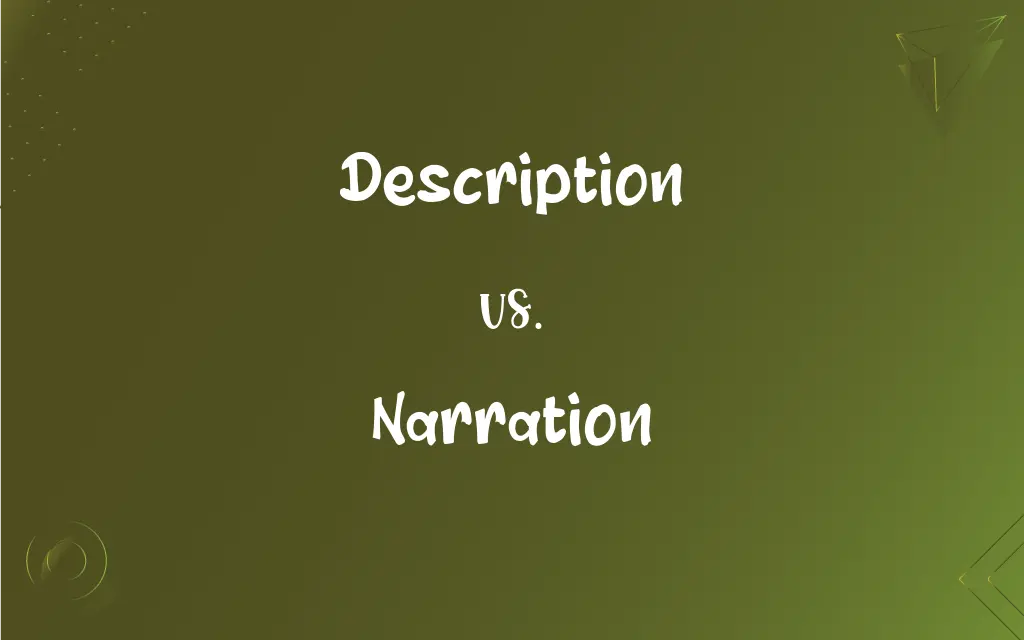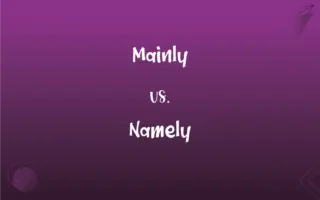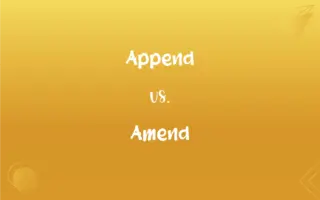Description vs. Narration: What's the Difference?
Edited by Aimie Carlson || By Janet White || Updated on November 15, 2023
Description provides details about characteristics and traits, while narration tells a story or recounts events.

Key Differences
Description involves detailing the characteristics, features, and traits of people, objects, or events. It uses sensory details to give the reader a vivid image or understanding of the subject being described. Descriptive writing aims to paint a picture in the reader's mind, focusing on the "what" of the subject, such as what it looks like, sounds like, or feels like.
Narration, in contrast, is about the sequence of events and the unfolding of a story. It involves a narrator who recounts events, whether real or imagined, to the reader or listener. Narration focuses on the "how" and "why," driving the story forward through events and actions. It is not just about creating a picture but also about explaining the progression and causality within a story.
When a writer provides a description, they're not moving the story forward but are pausing to delve into details that illuminate a particular point or moment. For example, in a novel, a description might focus on the intricate details of a character’s appearance or the setting where the action takes place.
Narration, on the other hand, involves telling the reader what the characters did, what happened to them, and what will happen next. It is the narrative voice that guides the reader through the story, providing context, background information, and the characters’ thoughts and feelings as they navigate through the plot.
While both are crucial elements of writing, description and narration serve different purposes. Description can exist without narration as in a catalog or a character sketch, whereas narration inherently includes some description as it recounts events, but its main function is to tell the story.
ADVERTISEMENT
Comparison Chart
Focus
Sensory and characteristic details
Sequence of events and storyline
Purpose
To paint a picture or scene
To tell a story or recount events
Writing Style
Illustrative and expressive
Sequential and explanatory
Elements
Imagery, adjectives, metaphors
Plot, characters, perspective
Function in Story
Provides depth and detail
Moves the story forward
ADVERTISEMENT
Description and Narration Definitions
Description
The act of depicting something, often using sensory details.
Her description of the perfume evoked images of a spring garden.
Narration
The process of narrating or relating a sequence of events.
The novel's narration shifted between past and present.
Description
A portrayal in words of the nature and characteristics of something.
The description of the haunted house made it seem eerily real.
Narration
The act of telling a story or recounting events.
His narration of the adventure captivated the audience.
Description
The process of outlining the distinctive features of something.
The job description outlined the responsibilities and qualifications needed.
Narration
A spoken or written account of connected events.
Her narration of her travels included both humorous and poignant moments.
Description
A statement that represents something in words.
The witness gave a detailed description of the suspect to the police.
Narration
The commentary accompanying a film or broadcast.
The documentary's narration provided insight into the lives of the animals.
Description
An illustrative account of something.
The brochure gave a colorful description of the tropical resort.
Narration
The act, process, or an instance of narrating.
Description
The act, process, or technique of describing.
Narration
The voice or persona that tells the story in literature.
The story’s narration was from the point of view of an omniscient narrator.
Description
A statement or an account describing something
Published a description of the journey.
Gave a vivid description of the game.
Description
A pictorial representation
Monet's ethereal descriptions of haystacks and water lilies.
FAQs
How does description support narration?
Description supports narration by providing the details that flesh out the settings, characters, and atmosphere in a story.
What is narration in writing?
Narration in writing is the act of telling a story, describing the sequence of events and the experiences of characters.
Can a story exist without narration?
Without narration, there would be no story, as narration is the act of telling the story itself.
What is a description in writing?
A description in writing is detailing the characteristics and sensory impressions of something to create a vivid image for the reader.
How can narration be unreliable?
Narration can be unreliable if the narrator is biased, misinformed, or intentionally deceptive.
Can a story exist without a description?
A story can exist without detailed descriptions, but it may lack vivid imagery that helps readers fully engage with the text.
How do authors use narration and description together?
Authors use narration to move the story forward and intersperse it with description to create a full, rich picture of the story's world.
Can narration be non-linear?
Yes, narration can be non-linear, jumping back and forth in time or relating events out of chronological order.
What’s the difference between a narrator and a describer?
A narrator tells a story, guiding the audience through the plot, while a describer provides details about certain aspects without necessarily telling a story.
Do all narratives have a narrator?
All narratives have a narrator, which can be a character within the story or an external voice.
How does the choice of narrator affect a story’s narration?
The choice of narrator affects a story's narration by influencing the perspective, bias, and depth of knowledge available to the reader.
Is descriptive writing important in narration?
Descriptive writing is important in narration as it enhances the reader's experience by providing a rich and immersive context.
What makes a good description?
A good description is one that engages the senses and paints a vivid picture, allowing the reader to visualize the scene or object clearly.
What is the difference between first-person and third-person narration?
First-person narration is told from the perspective of "I," while third-person narration uses "he," "she," or "they" and can offer a more detached or omniscient viewpoint.
What is an objective description?
An objective description attempts to accurately represent the subject without bias or personal feelings.
What is the role of description in non-fiction?
In non-fiction, description provides clarity and vividness to real-world subjects, helping the reader understand and visualize them better.
How do descriptive passages affect the pace of a narrative?
Descriptive passages can slow down the pace of a narrative, providing a pause from the action to develop the setting or characters.
Can dialogue be part of narration?
Dialogue can be part of narration; it's used to convey conversations between characters within the story.
What is the significance of sensory details in description?
Sensory details are significant in description because they create a more immersive and emotive experience for the reader.
What is the difference between direct and indirect description?
Direct description explicitly states details, while indirect description suggests them through mood, actions, and emotions.
About Author
Written by
Janet WhiteJanet White has been an esteemed writer and blogger for Difference Wiki. Holding a Master's degree in Science and Medical Journalism from the prestigious Boston University, she has consistently demonstrated her expertise and passion for her field. When she's not immersed in her work, Janet relishes her time exercising, delving into a good book, and cherishing moments with friends and family.
Edited by
Aimie CarlsonAimie Carlson, holding a master's degree in English literature, is a fervent English language enthusiast. She lends her writing talents to Difference Wiki, a prominent website that specializes in comparisons, offering readers insightful analyses that both captivate and inform.
































































